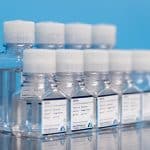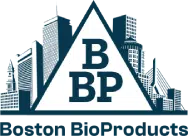Types of Buffers and Solutions
 Solutions are substances or compounds used as experimental reactants, buffers, solvents, or liquid solutes within many different sectors of biological research or manufacturing. Due to the vast array of solution types and their unique uses, this product category can be used to describe experimental reagents of all kinds. Solution types can include, but are not limited to:
Solutions are substances or compounds used as experimental reactants, buffers, solvents, or liquid solutes within many different sectors of biological research or manufacturing. Due to the vast array of solution types and their unique uses, this product category can be used to describe experimental reagents of all kinds. Solution types can include, but are not limited to:
- Buffer Solutions
Buffer solutions consist of a weak acid and its conjugate base or vice versa, stabilizing pH by neutralizing added acids or bases. They are essential for maintaining pH in various biochemical and chemical processes. These solutions are critical in research settings where pH-dependent reactions are conducted. Their ability to resist pH changes upon dilution or addition of small amounts of other chemicals makes them valuable in experimental protocols.
- Media Solutions
Media solutions provide essential nutrients for cell growth in microbiological and cellular studies. They typically contain amino acids, vitamins, and glucose, facilitating cell maintenance and experimental studies. The formulation of media solutions can be tailored to the specific needs of different cell types or experimental conditions. They are fundamental in culturing a wide range of microorganisms, cells, and tissues in controlled laboratory environments.
- Acid and Base Solutions
Used for various chemical reactions, acid and base solutions are key components in regulating the pH of various environments through titration. These can also be used for the disinfecting of tools and appliances, or as ingredients for larger reactions.
- Balanced Salt Solutions
Balanced salt solutions are key components used in cell culture and help regulate the proper intracellular environment, homeostasis, and movement of water in and out of various cell types. These solutions help simulate the correct milieu/environment of intercellular space and can allow scientists to better understand cellular communication and behavior.
- Inhibitor Solutions
Inhibitor solutions (for proteases and phosphatases) directly halt enzymatic reactions in biological processes and are proficient to maintain the stability of biomolecules. Selecting the appropriate inhibitor solution directly influences stability and success of bioprocessing, protein assays, purification, and research endeavors. Inhibitor solutions work to target specific enzyme mechanisms using an active ingredient or contain a cocktail of several active ingredients that yield broad-spectrum protection from enzyme-caused degradation.
- Metal Solutions
Often used in cell culture media and balanced salt solutions, metal solutions dissociate in polar solvents. This enables them to provide cations and anions to mixtures, effectively regulating Metal solutions can act as acids or bases, form complexes in solution, and influence the molecular mobility of many biological compounds in biological experiments.
- EDTA & EGTA Solutions
Acting as chelating agents, EDTA and EGTA bind to divalent metal cations, preventing them from interfering with chemical reactions. These solution types can be used in various applications within biochemistry and molecular biology. EDTA can be added to cell lysis buffers for use as a metalloprotease inhibitor to prevent protease activity. Whereas, EGTA has been shown to inhibit the zinc-dependent endopeptidases and matrix metalloproteinases (MMPs).
- Antibiotic Solutions
Antibiotics, also called antibacterials or antimicrobials are widely used to prevent the growth of invasive microbes in biological experiments. The antibiotic solutions often contain one, or sometimes multiple antibiotic types, depending upon the requirements. Antibiotic solutions are important in the regulation of bacteria prior to gene therapy, and testing for antibiotic resistance. In biological sciences, antibiotic solutions are widely used for various applications including the inhibition or regulation of cell wall synthesis, nucleic acid metabolism, and protein synthesis.
- Detergent Solutions
Detergents used in biomedical laboratories are also called surfactants (surface acting agents) because they decrease the surface tension of water. Detergents play a vital role in various biological processes, including the lysing of cells, release of soluble native and recombinant proteins, extraction and solubilization of membrane proteins, stabilization, crystallization, and extraction of DNA and RNA. Detergent solutions could be comprised of just one detergent or a mixture of multiple detergents. This depends on the biological experiment or experimental requirements.
- Acrylamide Solutions
Acrylamide solutions are solutions that contain acrylamide, which is a monomer that can polymerize to form polyacrylamide. Polyacrylamide is a gel-like substance that is commonly used for electrophoretic separation of nucleic acids and proteins by polyacrylamide gel electrophoresis (PAGE). The primary ingredients in polyacrylamide gel are acrylamide and Bis-acrylamide. Acrylamide is a water-soluble monomer which helps in forming a transparent, stable and insoluble gel. Bis-acrylamide functions as a cross-linking and polymerizing agent. Various solutions of acrylamide and bis-acrylamide are provided to have the relative ratio of both, depending upon the requirements.
- Sugar Solutions
Sugar solutions are often used as a fuel source for a variety of cell types helping to promote metabolic processes in living cells. . Based on the number of structural saccharide (monomeric) units present, sugars are classified into monosaccharides, disaccharide, oligosaccharides, and polysaccharides. Different sugar types and concentrations can help scientists maintain and learn more about their cell cultures.
- Fixative Solutions
Fixative solutions are liquids that are used to preserve biological tissues or cells from decay and damage. Fixatives solutions also enhance the rigidity and mechanical strength of cells, which is critical to withstanding the various, and sometimes rigorous, steps of the immunostaining procedure. They are usually made from chemicals that can cross-link, coagulate, or add to the macromolecules in the samples.
- Stains and Dyes
Stains and dyes are useful reagents in biological sciences, utilized across disciplines like microbiology and molecular biology to color cells and tissues. They enhance contrast during microscopic examinations, making it easier to distinguish between specimens and their surroundings. This coloring process reveals critical structures, aiding in the analysis and understanding of various biological samples.
Solutions at Boston BioProducts
Every solution is unique to its experimental application. Select the appropriate solutions from the catalog or design your optimal formulation with custom manufacturing options at Boston BioProducts.

